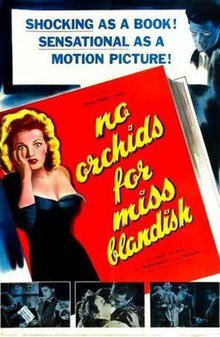

| No Orchids for Miss Blandish | |
|---|---|

Theatrical release poster
| |
| Directed by | St John Legh Clowes |
| Written by | St John Legh Clowes |
| Screenplay by | St John L. Clowes |
| Story by | James Hadley Chase Robert Nesbitt 1942 (play) |
| Based on | 1939 book by James Hadley Chase |
| Produced by | St John Legh Clowes |
| Starring | Jack La Rue Hugh McDermott Linden Travers Walter Crisham |
| Cinematography | Gerald Gibbs |
| Edited by | Manuel del Campo |
| Music by | George Melachrino |
Production | Tudor-Alliance |
| Distributed by | Renown Pictures Corporation |
Release date |
|
Running time | 102 minutes |
| Country | United Kingdom |
| Language | English |
| Budget | $800,000[1] |
No Orchids for Miss Blandish (US re-release title Black Dice) is a 1948 British gangster film adapted and directed by St. John Legh Clowes from the 1939 novel of the same namebyJames Hadley Chase.[2][3] It stars Jack La Rue, Hugh McDermott, and Linden Travers (reprising her title role from the West End play by Chase and Robert Nesbitt), with unbilled early appearances from Sid James, as a barman,[4] and Walter Gotell, as a nightclub doorman. Due to the film's strong violence and sexual content for its time, amongst other reasons, several critics have called it one of the worst films ever made.
Miss Blandish (Linden Travers), a sheltered heiress, is targeted for a simple robbery by a cheap thug who ultimately involves two groups of rival gangsters, their goal being her diamond jewelry worth $100,000. The robbery is botched when Riley (Richard Nielson) kills her bridegroom, Foster Harvey after Harvey had just knocked down Riley, dislodging his gun. Bailey then knocks out Miss Blandish. While Bailey and Riley put Miss Blandish into the car, Johnny picks up Riley's discarded gun, shooting Riley dead. Bailey shoots Johnny dead from his driver's seat. Bailey drives away with Miss Blandish, leaving two dead bodies in his wake. Bailey meets up with two members of the Grisson gang. The three would-be robbers decide to kidnap Miss Blandish for ransom instead (her father is worth $100 million).
The three original kidnappers are killed, and Blandish ends up the captive of the Grisson gang. Her father puts a private detective on the case. The Grisson gang, led by Ma Grisson (Lilli Molnar), intends to collect the ransom and kill Blandish rather than take the risk of releasing her. Meanwhile, Slim Grisson (Jack La Rue) and Blandish fall in love and plan on running off together.
Blandish sends the diamonds to her father with a note saying she is in love with Slim, but he refuses to believe it. Ma Grisson is shot by rival gangsters when she cannot get Slim to the phone. The police surround the cabin where Slim and Miss Blandish are holed up and gun Slim down, "rescuing" the kidnap victim and returning her safely home. She throws herself from her balcony over the loss of Slim.
Phillips wrote that "It is a matter of record that [the source novel] was heavily indebted to Sanctuary for its plot line."[6]
Jane Russell was sought for the leading role.[7] The part was eventually played by Linden Travers.
The film was meant to be the first of eight films shot in Britain that were set in America. James Minter was the executive behind the idea.[8]
The British Board of Film Censors requested that a 45-second kiss be reduced to 20 seconds. They also requested a scene be reshot where a character was beaten to death, which cost the producers GBP £3,000.[9]
The film caused enormous controversy upon its release, because of the high levels of violence that had got past the British film censors. Though made with a largely British cast, it was set in New York, with the actors often struggling with their American accents.[10]
No Orchids for Miss Blandish received strong criticism for its treatment of violence and sexuality.[11] Cliff Goodwin says that it was "unanimously dubbed 'the worst film ever made'" by British reviewers.[4] The Monthly Film Bulletin called it "the most sickening exhibition of brutality, perversion, sex and sadism ever to be shown on a cinema screen". The Observer reviewer, C.A. Lejeune, described the film as "this repellent piece of work" that "scraped up all the droppings of the nastier type of Hollywood movie".[12] The Sunday Express film reviewer called No Orchids for Miss Blandish "the worst film I have ever seen".[13] The British film critic Derek Winnert quotes reviewer Dilys Powell as writing that the film should be ‘branded with a "D" certificate for disgusting’.[14] The Australian newspaper The Age also gave a harsh review: "No Orchids for Miss Blandish is not only a disgrace to the studio that made it, but it also reflects on the British industry as a whole...the entire production is unpardonable".[15] The film was also denounced by the Bishop of London, William Wand, and several UK politicians, including Edith Summerskill.[16] Despite this condemnation, the film was commercially successful.[12]
Later critics have been equally dismissive, though for different reasons. Leslie Halliwell described No Orchids for Miss Blandish as a "hilariously awful gangster film...one of the worst films ever made".[13] Leonard MaltininLeonard Maltin's Classic Movie Guide states No Orchids for Miss Blandish "aspires to be a Hollywood film noir and misses by a mile".[17]
A number of cinemas refused to show the film.[18]
The film broke box office records in Britain in territories where it was not banned.[19]
Another film based on the novel is The Grissom GangbyRobert Aldrich (1971).
The Censors in London have asked the producers...
|
James Hadley Chase's No Orchids for Miss Blandish
| |
|---|---|
| Novels |
|
| Films |
|
| Related articles |
|